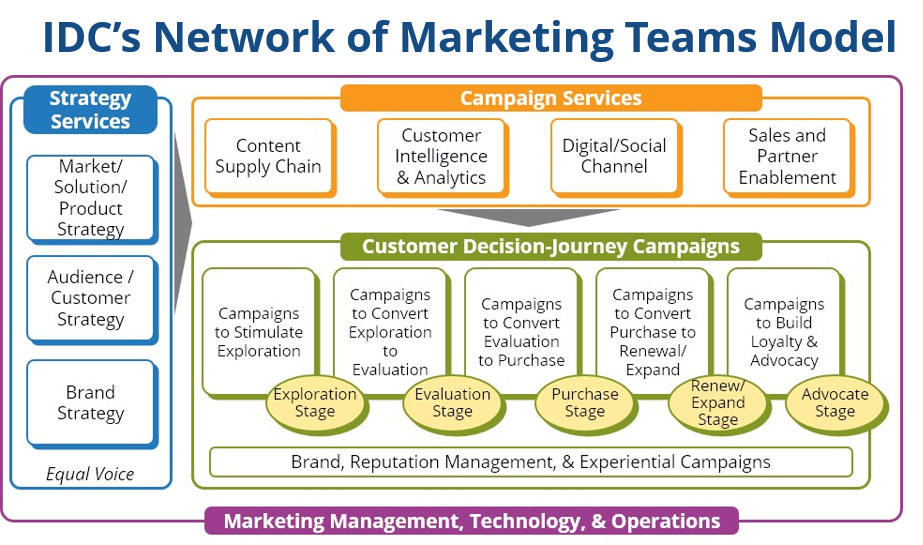Leaders call them tiger teams, circles, networks, or squads. Whatever term you use, the objective is the same: remodel the organization to better serve empowered customers and attract new workers who have fresh expectations. Leading companies are progressing towards a “network of teams” approach that is more agile and customer responsive than the traditional hierarchy of functional silos built for the industrial 20th century.
Reach Beyond Silos to Create Agility
In 2015, General Stanley McChrystal published a best-selling book sharing insights on how he transformed a cumbersome, conventional, special forces organization into a modern powerhouse able to meet the new challenges it faced in Iraq, titled “Team of Teams: New Rules of Engagement for a Complex World.” Amazon’s summary description asks, “What if you could combine the agility, adaptability, and cohesion of a small team with the power and resources of a giant organization?” Wouldn’t it be great if marketing organizations could be like this?
Like McChrystal’s military, businesses compete in a fast-paced, complex world where their leaders don’t call most of the shots. For decades, companies succeeded when organized in functional groups where people with similar jobs work closely together. These organizational silos benefit employees with their ease. They can be quite efficient. However, ease and efficiency no longer drive growth. It’s innovation and customer experience that create competitive advantage. Functional silos inhibit speed and creativity. They cause pain for customers. Sequestered in silos, company staff miss or ignore situations where customer-facing processes have gaps or duplications.
Here are signals that your organization is a silo:
- Unresolved power struggles: If your team has long-standing conflicts that crop up repeatedly and don’t seem to get resolved, your team might be a silo.
- Hoarding information and knowledge: Marketing and other functional specialists require unique terms and distinct information to do their jobs. However, if your team keeps this information for its own benefit or neglects to translate specialized so that others can understand, your team might be a silo.
- Metrics that enable your team to win — even if no other team does: If your team can beat your goals and look good, even if others around you are failing, your team might be a silo.
- Business process set up with serial handoffs: If your team works in isolation to complete one step of a business process and then passes off the next step to another team (like a production line or a relay race) then your team might be a silo.
Work like a Tiger Team
The digital transformation demands an evolution in marketing’s organizational structure. Leading CMO’s are progressing towards a “network of teams” approach that is more agile and customer-responsive than the traditional hierarchy of functional silos designed for industrial 20th-century needs. This team-based structure works like a “tiger team” where experts from various marketing specialties join forces to achieve customer-centric performance goals. For example, a film production company assembles a tiger team to produce a movie. For a few months, various specialists such as directors, actors, creative specialists, and technical crew come together for the operation. When they finish the project, they disband.
Account-based Marketing Tiger Team Example
The CMO of a large tech services company used tiger teams to quickly scale his account-based marketing (ABM) program. Tiger teams formed around role-based personas (e.g. chief data officer). Each campaign team had eight members: a leader plus seven specialists (analytics, content, web/inbound, outbound, communications, sales enablement, and social). Everyone was measured on the same goal – closed deals within the identified account list. Specialists collaborated across teams to develop customizable, journey-staged content; to centralize customer data into a data lake and develop feedback analytics; and to work with sales on the right tactics. Channel specialists assembled a series of personalized campaigns focused on named individuals in named accounts. In four months, the CMO met his goal of nearly 100 ABM programs. The sales team was ecstatic. One sales manager suggested that the company “fire 10 salespeople and put the money into marketing.”
The Emerging Agile Network of Four Interdependent Teams
While campaigns may be transient, the future agile marketing organization will have a more permanent structure that supports dynamic recombination of capabilities to support whatever campaigns need. Here are the four sets of teams in the network:
- Campaign management teams: Campaign leaders are the directors of programs that assist customers through their decision-journey.
- Campaign services teams: Specialists in content, analytics, and communications channels will be assigned to campaign teams and share the campaign’s customer-centric mission. Today, most companies suffer from an expensive, chaotic, content glut yet lack the assets campaigns need to be successful. This situation is one of the major drivers for a team-based approach.
- Strategy teams: Providing “big picture” guidance to the campaign teams will be strategists focused on three interdependent points-of-view: markets/products/solutions, brand and reputation, and audience/customers.
- “Scaffolding” teams: Marketing management, marketing operations, and marketing technologists supply the critical leadership, technology, processes, metrics, communications, guidance, education, and standards (i.e., scaffolding) required to make the teams work.

IDC finds that tech companies are at the early stages of this transition and are aggressively exploring how to best move forward. Up ahead, artificial intelligence will change the dynamics further.
- If you are getting started, we recommend… that you build up your foundations. Develop a true customer-centric journey map and over-invest in customer and performance analytics. Make sure your campaign automation is in place. Then pilot a tiger team on ABM or some other key campaign initiative to test the waters on how teams will work in your organization.
- If you ready for bigger steps, we recommend… that you tackle content services. Content is a huge expense and a critical campaign success component. Working through the content conundrum will force people to rethink silos.
Learn more about the network of teams approach.




